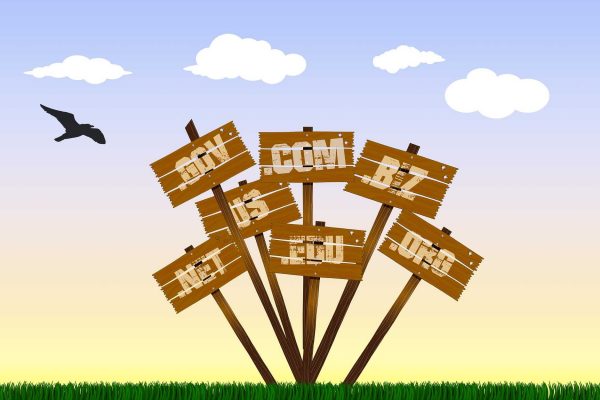
A domain name is that the address of your website that individuals sort within the browser URL bar to go to your website.
In easy words, if your website was a home, your Domain name would be its address.
More detailed description:
There can be a vast network of computers connected to every option through the world network of Internet cable. During this network, every PC will communicate with an alternate computer.
To identify them, each PC is assigned an IP address informatics address. It is a series of numbers that identify a specific PC on the web. A specific informatics address sounds like this:
66.249.66.1
Now it is very difficult to remember such an IP address. Imagine if you had to use such numbers to travel to your favorite websites.
The domain name was invented to solve this major problem.
Now if you want to visit an internet site, you do not need to enter an extended string of numbers. Instead, you will be able to see it by typing a simple memorized name in the address bar of your browser. For example, Saiinfoways Technologies.
How Do Domain Names Work?

To understand how domain names actually work, we'll take a look at what happens when you enter your browser.
How Domains Work
When you enter the name of a website in your browser, it sends an invitation to a worldwide network of servers called 1 System (DNS).
These servers then seek the name servers related to the domain and forward the request to those name servers.
For example, if your website is hosted on Saiinfoways Technologies.com, the server information for its name would be as follows:
- ns1.Saiinfoways Technologies.com
- ns2.Saiinfoways Technologies.com
These name server-class measurement computers are managed by your hosting company. Your hosting company can forward your request to a PC when your website is on hold.
This computer is called a web server. It has special software installed (Apache, Nginx ar 2 fashionable Internet server software). The online server currently acquires the online page and the objects of knowledge related to it.
Finally, it then sends this info back to the browser.
What Is The Difference Between a Domain Name and a URL?
A common resource locator (URL), sometimes called a web address, contains the site's domain name as well as other information including the transfer protocol and path. For example, the URL contains the domain name 'https://Saiinfoways Technologies.com/learning/', 'Saiinfoways Technologies.com', while 'HTTP is the protocol and '/ Learning /' is the path to a specific page. Website.
Who Manages The Domain Name?
Domain names are managed by all domain registries, which provide registrants with reservations of domain names. Anyone who wants to create a website can register a domain name with a registrar, and currently has more than 300 million registered domain names.
What Are The Different Types of Domain Names?

Thankfully, you don't need to miss all of these below because it can be a bit confusing. As a registrar; A domain name is generally used to enable you to differentiate between everyone - a popular term used collectively for second and third-level domains - and a subdomain.
- TLD - Top Level Domains
These classes measure at a very good level within the DNS structure of the Web. There are frequent different types of TLDs:
- ccTLD - Country Code Top Level Domain
Two-letter domains established for geographic locations; for example; .au denotes Australia. There square measure several differeWhen originally selected, solely residents of 1 country will register their various ccTLDs; however, over the years some countries have allowed parties outside their shores to register website names. Associate in Nursing example of this can be Tuvalu (.tv).nt kinds of TLDs:
In the case of .au domain names, strict rules still apply (and that's a good thing). For example, the .com.au registrant must still be Australian or register business interests in Australia. Registration for AU names means eligibility criteria.au is still strongly associated with Australia and is a great cause of trust and confidence among local and overseas online shoppers.
- gTLD - Common Top Level Domain
The most well-known common TLDs include .com, .net, .biz, .org, and .info - they can be registered by anyone, anywhere in the world. However, some of the recently released new GTLDs have various restrictions.
- IDN ccTLD - Internationalized Country Code Top-Level Domain
A top-level name with a specially encoded format that allows it to be displayed in a non-Latin character set (ie special characters).
There are various other levels below the TLD:
- Second-Level Domain
Exactly below the TLD in the DNS hierarchy, e.g. .com.au
- Third Level Domain
Directly below each other's level in the DNS hierarchy. Eg domainregistration.com.au
The difference between the second and third levels can be a bit misleading. For example, hotmail.com is noted on the second-level domain, although hotmail.com.au would be classified as a third level.
- Subdomain
Part of the next stratified name within the DNS hierarchy; Such as example.domain registration.com.au.Some services provide sub-domain "registration" - but this is generally not ideal for businesses and should probably avoid setting up a business website because the registrar of the upper hierarchy name has control over the address. Having your name can also help with credibility.
As mentioned, understanding the differences between all of the above is not really all that important - but you do need to know a little bit about how to enter a domain name. It is also a good idea to get some tips on choosing a domain before starting your search and registration process.
Request a Call Back
LET'S TALK
Discuss Your ideas and concept with us, and we bring your vision into reality.
Give Us a Call: +91-9599-999-042
Write To Us: info@saiinfoways.com
How to Register a Domain Name?
Different name providers use different systems and so unless this answer includes how the process typically looks, it may vary slightly depending on the provider. For more in-depth coverage, you can check our domain purchase guide.
You usually start by running a domain name search. Most domain name providers are available to type in your desired domain name and see if it is available. Here at Saiinfoways Technologies, we provide lots of suggestions for other possible domain names, which can be useful if you have already taken them for the domain you searched for.
Searching for a new domain name using the domain checker tool
From there, it is a matter of completing the checkout process and paying for your new domain name. Once it is registered, you will be given entry to a control room with all the necessary management tools.
What is a domain name? Explained domain for beginners
A domain name is essentially equivalent to the physical address of your website. In the same way, when GPS requires a street address or zipcode to give directions, a domain name is required to direct the web browser to the website.
A domain name takes the shape of 2 main components. For example, the domain name Facebook.com includes the website name (Facebook) and the domain name extension (.com). When a company (or an individual) purchases a domain name, they are able to specify which server the domain name points to.
Domain name registration is overseen by an organization called ICANN (Internet Corporation for Assignment Names and Numbers). ICANN specifies which domain name extensions are available and maintains a centralized database where the domain name indicates.

Each website you visit has two main elements: a domain name and a web server.
A web server is a physical machine that hosts the files and databases from which your website is created and sends them to people on the Internet when they arrive at your site from your machine.
A domain name is what people type in to access your site, and it indicates web browsers to the servers that store those resources. Without a domain name, people need to remember your server's specific IP address - and it's just not going to happen.
How to Transfer The Domain Name
Domain name registrars can also be transferred between domain names. However, there are unit sure conditions that have to be met:
60 or more days must have passed after registration or final transfer.
The domain name should not be in the event of redemption or pending deletion.
You must have an authorization code for your domain (also known as the EPP code).
Domain possession details should be valid and privacy protection services should be disabled.
Although transferring your domain is not mandatory, having all services in one place can simplify the management process.
Domain Transfer Initiation on Saiinfoways Technologies
Here at Saiinfoways Technologies, you can transfer domains from any domain name registrar. The process can take anywhere between 4-7 days to complete. However, our dedicated customer success team will be there to help you every step of the way.



